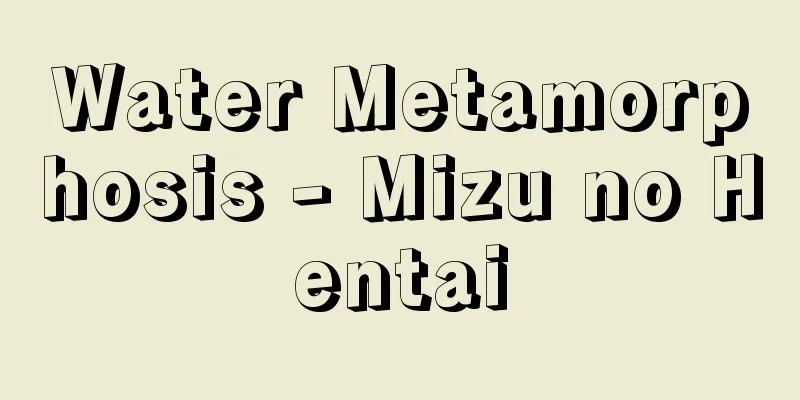Ako salt fields - Akoen

|
Salt fields were built in the coastal area of Ako County, Harima Province, which is now Ako City, Hyogo Prefecture. Salt production in Ako was already taking place as early as 756, and it is believed that salt production was carried out at Kumishiohama from the 10th to 13th centuries, and at Koshikiirihama from the 13th century, and then shifted to irihama salt fields in the mid-17th century. The irihama salt fields, which were created on average 1.5 hectares in size, and one salt pan were used as a production and management unit (ikkenmae), and the manager, called hamanin, employed about 10 people, including women and children, on a prepayment basis to work as wage laborers. At the beginning of the 17th century, the area of the salt fields was about 100 hectares in the coastal area, but as a result of land reclamation during the time of the Asano and Mori clans of Ako Domain, the area reached about 400 hectares at its peak, and production amounted to about 42,000 tons. In the Ako domain, salt was a domain monopoly from 1680 under the Asano clan and from 1809 under the Mori clan, but this was abolished in 1821 due to opposition from producers. Meanwhile, from the late Edo period, salt fields came to be concentrated in the ownership of a few local wholesalers who owned salt-carrying ships. This landlord system by local wholesalers continued even after the Meiji Restoration and was maintained even after the salt monopoly was implemented in 1905. After World War II, the import of cheap foreign salt and rising labor wages forced changes to the production system, and salt fields disappeared with the introduction of the Ryukabanshijoka method and the switch to the ion-exchange resin membrane method in 1972. Source : Heibonsha Encyclopedia About MyPedia Information |
|
播磨国赤穂郡,現兵庫県赤穂市の海岸部一帯に作られた塩田。赤穂での製塩はすでに756年には行われ,10世紀から13世紀にかけては汲潮浜(くみしおはま),13世紀からは古式入浜(こしきいりはま)による製塩が行われていたとみられ,17世紀半ばから入浜塩田へと移行した。造成した平均約1.5haの入浜塩田と塩釜1基を生産・経営の一単位とし(一軒前),浜人(はまにん)と呼ばれる経営者が女・子供を含む10人ほどを前貸しで雇用し,賃労働に従事させた。塩田の面積は17世紀初頭には沿岸地域の約100ヘクタールであったが,赤穂藩浅野氏・森氏の時代に干拓が進められた結果,最盛期には約400ヘクタールに達し,生産額は約4万2000トンに上っていた。赤穂藩では浅野氏時代には1680年から,森氏時代には1809年から塩を藩の専売としたが,1821年生産者側の反対で中止された。一方江戸時代後期からは塩田が塩廻船を持つ一部の在地問屋の所有に集中するようになった。このような在地問屋による地主制は明治維新後も続き,1905年の塩専売制施行後も維持された。第2次世界大戦の後は安価な外塩の輸入,労働賃金の高騰などで生産態勢の変革を余儀なくされ,流下盤枝条架法(りゅうかばんしじょうかほう)の導入,1972年のイオン交換樹脂膜法への転換により,塩田は姿を消した。
出典 株式会社平凡社百科事典マイペディアについて 情報 |
Recommend
Ginzo Uchida
Year of death: July 20, 1919 Year of birth: Januar...
Kotel'nyi (English spelling) Kotelnyi
…From south to north, they are called the Lyakhov...
Penis envy
Freud's view of female sexuality gives penis e...
Physics - English
Introduction The origin of the word physics, phys...
Peroxidase reaction
A special cytochemical staining method used to cla...
Firth, Colin
Born: September 10, 1960. Grayshott. British actor...
high moor
...fens are broadly divided into mineralotrophic ...
Polystichum retroso-paleaceum
…[Shigeyuki Mitsuda]. … *Some of the terminology ...
Acromion
…the glenoid cavity is shallow, allowing for grea...
Anonymous sect - Mumyoushou
A one-volume book on waka poetry from the early K...
Karloff, B.
... Universal gained a good reputation with the m...
Belly protector - Haraate
The simplest armor of the Middle Ages, worn only o...
Mazak
…An American brand name for a zinc alloy for die ...
Reference date - Kijumbi
The date on which a company designates a certain d...
Sakhalin
A long, narrow Russian island facing the Sea of ...









